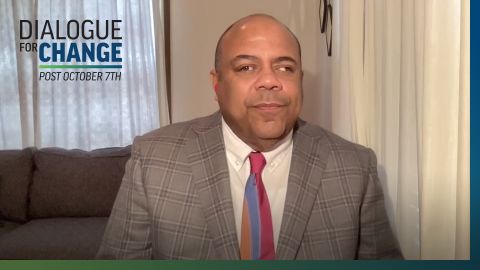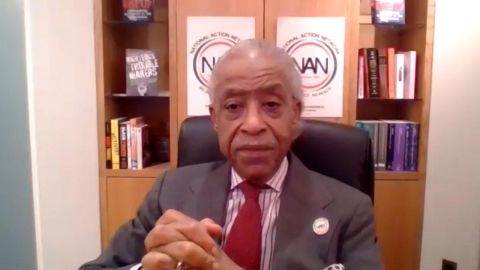Maryland take inaugural steps towards reckoning its violent, racist past
More than 6,500 Black people were lynched in America between the end of the civil war in 1865 and 1950. These murders were carried out not only in the deep South, but in states like Maryland, which is now the first state in the nation to come to terms with its history of racial terror by starting a truth and reconciliation process. Special Correspondent Brian Palmer reports as part of our ongoing series, “Exploring Hate: Antisemitism, Racism and Extremism.” Warning: the segment contains graphic descriptions of violence.
TRANSCRIPT
Hari Sreenivasan:
As we mark Juneteenth today, it’s important to remember that this, of course, was not the end of racial terror in the United States. More than 6,500 Black people – mostly men – were lynched between the end of the Civil War in 1865 and 1950, according to The Equal Justice Initiative, a nonprofit that researches and memorializes these crimes.
While we might imagine that these acts of racial terror were only in the deep South and the former confederacy, many border states were not immune—including Maryland, which is now the first state in the country to formally start a truth and reconciliation process to reckon with this painful and violent history. Special Correspondent Brian Palmer has our report, which is part of our ongoing series “Exploring Hate: Antisemitism, Racism, and Extremism.”
A quick warning that this segment includes graphic descriptions of violence.
Brian Palmer:
In the center of downtown Salisbury, on Maryland’s eastern shore, the historic Wicomico county courthouse stands today as it did in 1931. Back then this supposed hall of justice was the site of a brutal, extra-judicial killing: the lynching of 23-year-old Matthew Williams.
Charles Chavis, Jr.:
You know, he was a normal child. I mean, he played with his cousins. He loved going to watch pictures. And during the Depression, he had money in two bank accounts, he had a stable job, was employed and was able to maintain employment.
Brian Palmer:
Charles Chavis, Jr. is a historian at George Mason University, and the author of the forthcoming book, “The Silent Shore: The Lynching of Matthew Williams and the Politics of Racism in the Free State.”
The horrific lynching of Matthew Williams was reported widely at the time, including in the Afro-American, a Black-owned paper in nearby Baltimore.
While there are differing accounts of what happened that day, what we do know is that Williams worked for a wealthy white business owner in Salisbury. After an altercation, Williams’ boss was dead and Williams himself suffered several gunshot wounds but was still alive.
Once word got out, a white mob formed at the hospital where he had been taken. The nurse in charge of the segregated Black ward reportedly stepped aside to allow his abduction.
Charles Chavis, Jr.:
There’s a famous quote that’s actually published in The Baltimore Sun where she says, ‘If you’re going to take him, take him quietly.’
Brian Palmer:
The injured Williams was thrown from a hospital window and dragged several blocks to the courthouse. The white mob tortured, hanged, and then burned his body. The crime was captured in this drawing that ran in the Baltimore Morning Sun.
Charles Chavis, Jr.:
Williams was not only lynched on the courthouse lawn, but his body was taken after, you know, when it was burned to the Black section of Salisbury, put on display for onlookers to drive by while the local police department directed traffic.
Brian Palmer:
No one has ever been held accountable for his killing.
Matthew Williams is buried somewhere in this cemetery, his grave unmarked. But after nearly 90 years since the lynching of this Black man, the city of Salisbury is beginning to acknowledge its history of white racial violence.
James Yamakawa:
When the mob came for him, they faced little resistance.
Brian Palmer:
On a recent Saturday, a group of several dozen people gathered to retrace the path that the mob took as it dragged Williams to his death, from the hospital where he was kidnapped, (today) still a medical center, across the Wicomico River, to the courthouse lawn,
The occasion was the unveiling of a sign memorializing Williams, an unidentified Black man found beaten to death a day later —and believed to be a victim of the same mob—and Garfield King, an 18-year-old Black man lynched in the county in 1898.
Amber Green:
This marker is not the finish line. It’s literally us passing the baton on a relay race.
Brian Palmer:
Local activists Amber Green and James Yamakawa helped lead the effort to get a marker installed for these three victims of racial terror. Their journey started more than five years earlier after they had seen a very different historical marker just feet from where Matthew Williams was murdered.
James Yamakawa:
We walked downtown and past the courthouse…
Amber Green:
And we saw the Confederate marker.
James Yamakawa:
We saw this Confederate marker there. And we were like, who the heck is this guy?
Brian Palmer:
That plaque on county land, honored John Henry Winder, a Confederate general born on Maryland’s eastern shore.
Amber Green:
It wasn’t the issue that it was a Confederate marker. It was the fact that you had the audacity to put a Confederate marker less than 100 feet from where a Black man was lynched. I’m not, I’m not, I’m not letting that go.
Brian Palmer:
After years of fighting by activists to have it removed, officials quietly took it down last June, after the murder of George Floyd.
Opposition to the Confederate sign and support for a lynching marker came not just from activists, but also from Salisbury’s Democratic mayor, Jake Day.
Mayor Jake Day:
Just as government and society’s formal processes can be used to protect race-based intimidation, violence and inequity, so too can it bring those long-standing but rotten pillars tumbling down.
Brian Palmer:
In January 2020, the city of Salisbury formed a lynching memorial task force, to start a process to erect a memorial.
Jake Day:
As the mayor, I’ve got an obligation to do what my predecessor back then didn’t do. He told our citizens, if you’re Black, stay inside tonight to avoid getting killed, getting lynched. What I realize is I’ve got to say, come out. This is your city. Come stand with me in the middle of the city, we’ll put up a sign that says this space is a space where we won’t forget what happened and we’ll never let it happen again.
Brian Palmer:
It’s not just the city of Salisbury that’s beginning to reckon with the lynchings in its not-so-distant past.
In April of 2019, Republican governor Larry Hogan signed a law that created the Maryland Lynching Truth and Reconciliation Commission. It’s the first body of its kind in the United States. Charles Chavis, Jr. is the vice-chair.
Charles Chavis, Jr.:
There’s a hyper emphasis that’s placed on states in the Deep South. Maryland only having around 44 documented lynchings, but nowhere near the amount that Mississippi and other states had, it gets overlooked. But what we have to recognize is that there are other communities who suffered both systemic racism and racial terror and their wounds have yet to be healed as well.
Brian Palmer:
The commission is staffed by the Maryland attorney general’s office and commissioners include historians and community members. Starting this fall, the commission will hold public hearings around the state.
Charles Chavis, Jr.:
Our main task by the law is to investigate and research each individual case. And so we are pulling together a narrative of what happened. And we see it as a part of the healing process and the part of radical truthtelling that has to take place and be centered as we begin to move towards whatever type of remedies we have to focus on truth. Truth must be first.
Brian Palmer:
For descendants of Matthew Williams, knowledge of his murder came only recently, almost 90 years after the event.
Jeannie Jones:
I get a phone call, you know, wee hour, late-night, early morning, ‘Jeannie, your cousin’s been lynched,’ and, you know, I’m like, what?
Brian Palmer:
Jeannie Jones learned about the lynching of Williams last year after Chavis, and a genealogist he was working with got in touch with her family.
Williams, whose nickname was Buddy, was her great-grandmother’s nephew. Jones had never heard the story of his death.
Jeannie Jones:
I felt like I just got a black eye. That’s how I felt. I said, why isn’t this written somewhere to such a heinous crime happened, you know, and where’s the accountability for it?
Brian Palmer:
Jones brought her 13-year-old daughter Jordyn with her to Salisbury to participate in the unveiling where they read a poem.
Jeannie Jones:
I am the descendant of Matthew Williams. Born in 1908. Another baby was born in 1973. His name, George Floyd.
Jeannie Jones:
It hurts. It hurts, and it will continue to hurt. Some healing does happen that we’re having this memorial. I can go back, my daughter can go back, her children can go back and say, this has happened. What have we learned? How have we done better? Has anything changed?
Brian Palmer:
Chavis says that facing and memorializing lynching is a vital step this country must take to grapple with violence against African-Americans, past and present.
Charles Chavis, Jr.:
The biggest task that we have moving through this century is to really find a way to connect with our shared humanity and see the humanity of individuals, not only from Matthew Williams, but also to George Floyd, Breonna Taylor and others, because there is something that has happened over time that has allowed us to detach to where when we see a Black body either swinging from a tree or laying on the ground, being choked by a knee, that their life is not as valuable as someone other, some others. We have to recognize that at the end of the day, these individuals are somebody’s children.
Brian Palmer:
For activists James Yamakawa and Amber Green, the installation of this marker was a hard-won victory, but it’s hardly the end of a long struggle for social justice in Wicomico county, they say.
Amber Green:
I think a lot of people want us to be satisfied and feel like, you know, pat ourselves on the back. Like this is a major accomplishment. And it is. I don’t want to downplay the work and the energy. But I think it would be naïve to not think that there is still so much that needs to be done. I see the signs as just a step.
James Yamakawa:
It’s a step. It’s a reminder and it’s going to piss some people off because it’s a reminder, people will be walking there and seeing it. They can’t not see it. Yes, people could turn off, turn it off in their own heads but not everyone’s going to.
Jake Day:
I think the community recognizes that in the hearts of most people, they can understand why we must do this, why this is not a negotiation.
Brian Palmer:
I would imagine that a lot of the resistance you’re getting is from a particular portion of the white community. How do you deal explicitly with those issues of race when they actually come up?
Jake Day:
Maybe more defensively than I should. People who look like me, mainly white men, but white people did things that were inhumane, inhuman and an embarrassment to what should be our entire species. But we did those things. So turning that corner, I think, means being really honest and really frank and saying we’re got, we are going to be a different society today.
Singer:
Lift every voice and sing…
Brian Palmer:
This lynching memorial is now firmly planted in the ground – symbolism made solid. Figuring out what comes next, and what can be done to remedy historical racial injustice—and to address racial atrocities—remains a much harder question.
What does genuine truth and reconciliation look like to you? And I mean, concretely, in our culture and our education? Like what, what does it look like?
Charles Chavis, Jr.:
So I wouldn’t use the term reconciliation because in many ways America was never united or together with the communities in which it has oppressed. But what we can talk about is social transformation as well as racial healing. And I believe that this transformation is going to be done effectively and holistically when it’s done at the community level, such as it’s being done here in Salisbury.
Singer:
Facing the rising sun…
Charles Chavis, Jr.:
Maybe reconciliation is something that we can obtain one day, but we’re nowhere near that. And instead of jumping to the necessary conclusions as to what we want the transformation to be the community, the descendants of victims should decide and be a part of that process.


